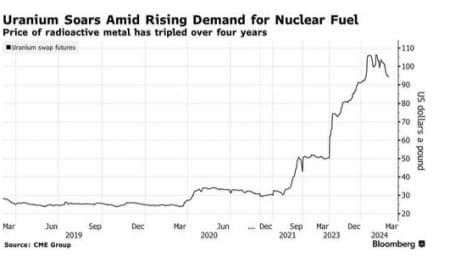U.S. Mines Race to Restart As Uranium Prices Skyrocket
It's been a long time coming, but the bulls are finally back in uranium. And with them comes the restart of multiple uranium projects that have been taken offline in the years while the commodity slouched in price.
We have long stated here on Zero Hedge that nuclear power is an obvious win/win: it's clean, it's safe, it provides robust power and, most importantly to our liberal friends, it has minimal emissions. So why isn't it more prominent?
In the wake of the 2011 Fukushima nuclear disaster, uranium mining in the United States, particularly in Wyoming, Texas, Arizona, and Utah, experienced a significant downturn.
This decline wasn't helped by uranium prices plummeting and nations such as Germany and Japan moving away from nuclear energy. However, as global efforts to reduce emissions renew interest in nuclear power, and as leading uranium producers face challenges in meeting demand, prices for the metal have risen sharply, a new Bloomberg report says.
This resurgence in prices is offering previously unprofitable American uranium mines an opportunity to re-enter the market and address the supply shortfall.
According to the report, as the Prospectors & Developers Association of Canada's annual meeting takes place in Toronto, attracting thousands from the mining industry, uranium will be a key focus.

With participants including major uranium firms like Denison Mines Corp., Fission Uranium Corp., and IsoEnergy Ltd., the event highlights the growing importance of uranium in the context of climate change and nuclear power.
Related: Artificial Intelligence Could Trigger a Natural Gas Boom in Europe
The International Atomic Energy Agency predicts a significant rise in uranium demand, foreseeing a need for over 100,000 metric tons annually by 2040, necessitating a near doubling of current mining and processing efforts.
Scott Melbye, executive vice president of Texas-based Uranium Energy Corp. said: “We’re in an old-fashioned, plain-and-simple supply squeeze. Demand is increasing again, with new reactors coming online.”
John Ciampagli, Chief Executive Officer of Sprott Asset Management added: “The industry is clearly trying to respond with smaller mines reopening, but when you have a mine that hasn’t operated for that long, it’s obviously not very substantive.”
Related: 2 Ways to Play Europe’s $800 Billion Energy Crisis
Cameco has resumed operations at MacArthur River and Key Lake, the world's largest high-grade uranium mine and mill in Saskatchewan, Canada, after halting from 2018 to 2021 due to poor market conditions.
The reopening of U.S. mines signifies a comeback for an industry that nearly vanished five years ago, with production plummeting to 174,000 pounds in 2019 from a peak of 44 million pounds in 1980. This decline was accompanied by increased reliance on uranium imports from nations such as Canada, Australia, Kazakhstan, and Russia.
Amid geopolitical tensions, particularly sanctions on Russia after its 2022 invasion of Ukraine affecting uranium shipments from Kazakhstan, the U.S. is motivated by both supply security and political reasons to boost its uranium production. The Uranium Producers of America suggests the U.S. will need to open 8 to 10 major new mines within the next decade to meet demand.
By Zerohedge.com
More Top Reads From Oilprice.com:
